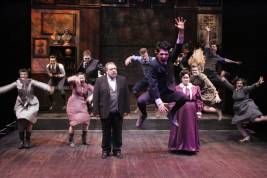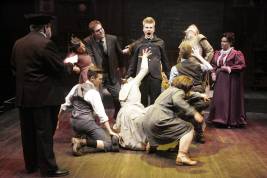
Broadway’s Spring Awakening gets a fresh re-envisioning as the maiden entry in La Mirada Theatre For The Performing Arts’ brand new “On Stage” series, which takes the usual stage area of the 1251-seat theater and converts it into a 200-seat thrust-stage theater-within-a-theater, giving audiences a Spring Awakening that not only stands out for its originality in concept and staging, but one that has every ticket-holder seated within seven rows of the performance area, insuring the kind of up-close-and-personal experience no big-stage La Mirada production could possibly offer.
 Steven Sater and Duncan Sheik’s Tony-winning musical takes as its inspiration Frank Wedenkind’s 1891 German-language drama, one that broke plenty of ground indeed with its depiction of on-and/or-offstage masturbation, child abuse, bondage, rape, abortion, and suicide among 14-year-olds just now awakening to their sexuality. No wonder Wedenkind’s late nineteenth-century shocker wasn’t staged on Broadway until 1916 and ended up closing after a single performance.
Steven Sater and Duncan Sheik’s Tony-winning musical takes as its inspiration Frank Wedenkind’s 1891 German-language drama, one that broke plenty of ground indeed with its depiction of on-and/or-offstage masturbation, child abuse, bondage, rape, abortion, and suicide among 14-year-olds just now awakening to their sexuality. No wonder Wedenkind’s late nineteenth-century shocker wasn’t staged on Broadway until 1916 and ended up closing after a single performance.
Very much a groundbreaker in its own way, Sater and Sheik’s musical has proved considerably more successful than its source material, nabbing eight 2007 Tonys including Best Musical, Book, and Score, and running nearly 900 performances on Broadway, one of New York’s most thrilling evenings of musical theater since Rent revolutionized the Great White Way in 1996.
Like Wedekind’s original play, Spring Awakening (The Musical) centers of the lives of its three teenage protagonists: the handsome, popular, self-confident Melchior (Austin MacPhee), his introverted, inhibited, wet-dream-plagued classmate Moritz (Coby Getzug), and the all-too-innocent but no less sexually inquisitive girl-next-door Wendla (Micaela Martinez). We also meet Melchior and Moritz’s ever-horny classmates and Wendla’s equally randy girlfriends, a pair of older actors standing in for all the adults in these teens’ lives.
What makes Spring Awakening work so brilliantly is not simply Sater’s streamlining of Wedekind’s melodramatic plot threads. Singer-songwriter-pop star Sheik’s catchy alternative rock score, the likes of which had probably never before been heard on a Broadway stage, and Bill T. Jones’ brilliantly innovative choreography turned Spring Awakening into a mainstream (and cult) international phenomenon.
The show begins quietly, with sexually burgeoning Wendla wondering if she’ll ever be told the truth about man-woman relations in “Mama Who Bore Me,” followed by a very funny sequence in which her highly embarrassed mother (Linda Kerns) avoids the question entirely, an omission which proves ultimately disastrous. The song takes on a rock beat as Wendla’s girlfriends join her in a reprise, after which we visit Melchior and Moritz in Latin class, the former attempting to rescue the latter from the ire of their monster of a teacher (Michael Rothhaar), when the burning need to express what’s going on inside their minds and bodies suddenly erupts.
The first chords of “The Bitch Of Living” had Broadway’s Melchior suddenly drawing from within his school uniform a previously-hidden mike, a gesture so defiant, unexpected, and utterly thrilling it made me a Spring Awakening fan for life. In fact, for this reviewer at least, much of Spring Awakening’s magic has come from hand mikes that take us in an instant from 19th Century reality into these characters’ 21st Century emotions. In a previous review, I even went so far as to give potential Spring Awakening stagers the following advice: If you can’t do it with mikes, don’t do it at all.
Imagine my astonishment, therefore, at discovering that despite daring to ixnay those technical gadgets that have heretofore been essential to Spring Awakening’s success, director Brian Kite has found an equally effective way to create the musical’s two very different worlds, the late 1800s in which Spring Awakening’s teenage cast of characters actually live, and the 2013 one in which they express their emotions through contemporary alternative rock.
The key to this is Steven Young’s phenomenal lighting design, one which morphs from a naturalistic plot in dialog scenes to rock concert-ready flash and pizzazz the second Melchi, Moritz, Wendla and the gang launch into song. This mike-free approach not only preserves the original, living-in-two-worlds concept, it allows characters to have both hands free, thereby enabling choreographer Dana Solimando to create dance moves that pay only the slightest homage to Jones’ originals, then take off on their own and do some extraordinary new things.
 Solimando’s choreography takes adolescent urges just bursting to break free and expresses them in dramatically stylized movements, the most striking instance of which comes in The Pink Floyd-esque “Touch Me,” in which Solimando’s choreography reveals more specifically than ever before the budding sexual orientations of its youthful cast of characters.
Solimando’s choreography takes adolescent urges just bursting to break free and expresses them in dramatically stylized movements, the most striking instance of which comes in The Pink Floyd-esque “Touch Me,” in which Solimando’s choreography reveals more specifically than ever before the budding sexual orientations of its youthful cast of characters.
This is just one of Spring Awakening’s quieter moments, which feature some of Sheik and lyricist Sater’s most memorable compositions including the anthem-like “I Believe,” which sets the stage for Melchior and Wendla’s lovemaking, and the exquisitely sad “Left Behind,” sung at a funeral for one of the teens are just three among many such songs.
Without these musical numbers, Spring Awakening would simply be an abbreviated version of Wedenkind’s original play, albeit skillfully abridged by book-writer Sater. With them, the struggles of nineteenth-century adolescents seem every bit as relevant to today’s teens as the ones they face on a daily basis, as if contemporary souls were inhabiting these long-deceased youths. Melchior, Wendla, and Moritz may have been born in the 1870s, but their dilemmas (like the consequences of Wendla’s insufficient sexual education) still ring true in 2013.
Just as he did in last year’s Miss Saigon, director Kite has had his actors approach Spring Awakening’s song lyrics as if they were dialog, concentrating on the meaning of each line, making his cast’s interpretations of both Stater’s lyrics and his spoken dialog particularly powerful and authentic. Add to that my favorite Kite moment in which an already moving scene between Melchior, Moritz, and Wendla this time actually takes your breath away, and you’ve got just one of Kite’s multiple strokes of directorial genius.
Not surprisingly, the La Mirada cast (about as age-appropriate an ensemble as you’re likely to see in any Spring Awakening) do all-around standout work.
UCLA sophomore MacPhee gives Melchior the sweetness, straightforwardness, and innocence of a book whose pages have mostly not yet been written on. Recent CSUF grad Martinez creates yet another vivid portrait, this time of a girl on the verge of womanhood and particularly vulnerable to its challenges, both emotional and sexual. And UCLA student Getzug, who originated the role of Moritz in the non-Equity National Tour before joining AEA, uses that experience to give us a deeply troubled teen without resorting to an over-emphasis on the character’s quirks that can make Moritz just plain weird. All three are as vocally strong as it gets.
Among the boys, Nick Adoro’s cocky, heartthrob-handsome Hanschen and Christopher Higgins’ heartbreakingly innocent Ernst play their pivotal Act Two scene (and sing “The Word Of Your Body” reprise) with the very best blend of honesty, humor, and teenage desire that I’ve seen, allowing us to laugh at their quirks but never, as has often been the case, at the characters themselves. Alex Mendoza’s great big teddy bear of a Georg and Bruce Merkle’s adorably awkward Otto are terrific as well.
Then there are the girls, splendid all of them, from Jennifer Foster’s spunky Anna, to Cailan Rose’s straight-arrow Thea, to Salisha Thomas’s wounded Martha, the latter performing “The Dark I Know Well” with smoky pipes that foretell great things from the CSUF junior. Finally, Alyssa M. Simmons gives us the most richly layered Ilse I’ve seen, and solos “Blue Wind” with particular power and depth.
Kerns and Rothhaar play each and every adult character with such specificity that even without minor costume adjustments, it would be clear that each one is a distinct and finely rendered gem of a performance.
Musical director John Glaudini, the production’s live orchestra, and its cast of performers nail Sheik’s orchestrations, Annmarie Milazzo’s vocal arrangements, and Simon Hale’s string orchestrations to perfection.
The undisputed design star of La Mirada’s Spring Awakening is the aforementioned Young, whose contributions are pivotal to Kite’s reconception of the Broadway hit, but he is not the only designer deserving to be singled out. Scenic designer Rich Rose gives Spring Awakening a meticulously detailed backdrop that reflects the worlds in which these teen characters live as do costumes rented from San Jose Repertory Theatre, a striking blend of period designs and contemporary footwear, and Sarah Wolfe’s distinctive hair and makeup design. Kudos go too to Terry Hanrahan’s carefully chosen properties and Josh Bessom’s crystal-clear sound design.
William Coiner is production stage manager, Buck Mason production manager, David Cruise technical director, Julia Flores casting director, Alexis Jacknow assistant director, Gretchen Dawson assistant choreographer, and Jess Manning assistant stage manager.
La Mirada Theatre’s Spring Awakening is the seventh different staging I’ve seen since catching the First National Tour in 2008, and the best so far in combining elements of the original that helped turn it into a hit with new ideas that make this particular production one-of-a-kind. Then again, considering the track record set by La Mirada Theatre For The Performing Arts, director Brian Kite, choreographer Dana Solimando, and its already experienced young cast, I would have expected nothing less.
La Mirada Theatre for the Performing Arts, 14900 La Mirada Boulevard, La Mirada.
www.lamiradatheatre.com
–Steven Stanley
March 22, 2013
Photos: Michael Lamont


 Since 2007, Steven Stanley's StageSceneLA.com has spotlighted the best in Southern California theater via reviews, interviews, and its annual StageSceneLA Scenies.
Since 2007, Steven Stanley's StageSceneLA.com has spotlighted the best in Southern California theater via reviews, interviews, and its annual StageSceneLA Scenies.







 COPYRIGHT 2024 STEVEN STANLEY :: DESIGN BY
COPYRIGHT 2024 STEVEN STANLEY :: DESIGN BY